PURPOSE This study comprehensively compared the perception and interaction of player–coach in the development of mental toughness in soccer. METHODS Data were collected through semi-structured individual interviews from 12 participants (6 athletes and 6 coaches), analyzed using the grounded theory by Strauss and Corbin, and they were compared to the group of athletes and coaches, respectively. RESULTS The following results were obtained: (1) Both athletes and coaches recognized that the experience of coping with the pressure present in competition was a central phenomenon in the development of mental toughness. (2) Regarding the situation and condition that lead to coping with pressure, the athletes emphasized the individual's goal orientation in the context of competitive situations and environmental conditions, while the coaches emphasized the athletic attitude toward competition and development in childhood. (3) The athlete–coach interaction was identified as an intervening condition affecting the experience of coping with pressure. (4) As the action–reaction strategy for the development of mental toughness, the optimistic thinking was emphasized for athlete and achievement-oriented thinking for coach; thus, it differed in the characteristics of mental toughness. CONCLUSIONS This study presented the results of an integrated comparison of mental toughness, which can vary depending on the contextual specificity (soccer) and the subject of perception (athlete– coach), especially indicating the importance of the player–coach interaction, which can contribute to the strategy to be used in mental toughness development.
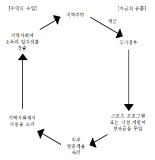
A number of global cities and local cities facilitate local economies and development by utilizing sports. However, their strategy is likely to be a short-term and one-time policy, which does not continuously strengthen their development. Therefore, the use of sports needs to be considered as more specific and longer term strategies for local development. This study examines the concept and role of sports city focused on cases of overseas sports cities, and successful and ideal cases of background and features of sports cities were analyzed to promote and lead the direction of improvement of sports cities in Korea. Consequently, strengthening a city’s sport capability and connecting it to local development need to be met to become a city into a successful sport city. To do so, it should premise recognition that sports cannot be treated separately from other urban policy area and it needs to invest in sports facilities, hosting sports events and competitions, and sports clubs based on the recognition for the importance of sports. Moreover, it needs a marketing strategy for branding and differentiation through sports of a city’s expertise. Finally, to make sports act as a catalyst to strengthen the process of an integrated city’s competitiveness, it requires a local government’s strong leadership and organization capacity of stakeholders.

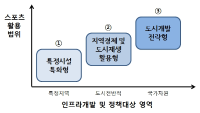






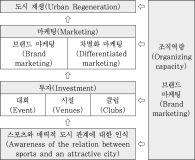

The purpose of this study was to confirm the differences between winner and loser groups of national team participated in the World Taekwondo Championships statistically and trends of psychological status according to applying mental coaching. In order to achieve the purpose it was the selection of 16 national members participated in the 2013 World Taekwondo Championships in Puebla. Data was selected by TOPS(test of performance strategy). The survey was conducted before and after applying the mental coaching and the game soon after. Data processing results were calculated utilizing Excel and SPSS 21.0 version. Based on the findings issue the conclusions were as follows. First, the psychological state of the winner and loser groups showed a different trend in the self-talk, emotion control, performed automatically, imagery, struggle, negative thinking, relaxation, condition factor. Winner group was shown maintenance or better trends of psychological state in the three times measurements on the other hand, loser group was shown decrease in the game soon after. Secondly, winner and loser groups are statistically significant differences in the psychological state of competition in self-talk, struggle, negative thinking, solving tension factors. In other words, The winner group had higher score in the four factors than loser group in the competition.

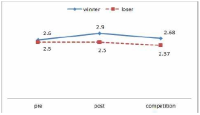
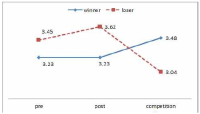
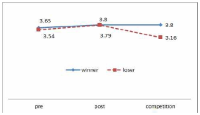
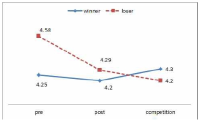
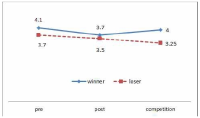
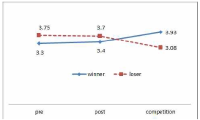
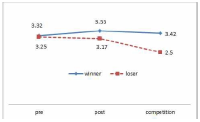
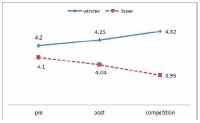
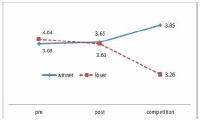
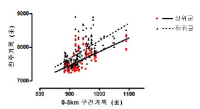
The purpose of this study was to examine that the reciprocal relationship between every 5km and full course running time record. In this study we extended our research scope to investigate whether any notable running time differences were existed among top level of marathoners. Comparisons were made using data which were drawn from 34 championship competitions had been held between year 2000 and year 2009 in Korea. Total 340 full time data was obtained from 340 marathoners who successfully completed their 42.195km running race, and divided into one of two categories, either upper ranked group (URG, ranked 1st~5th position in competitions they participated) or lower ranked group (LRG, ranked 6th~10th position in competitions they participated). Mean and standard deviation were calculated from SPSS (VER. 20.0), and repeated measures of ANOVA and Pearson's correlation was adopted to perform statistical analyses. There was no statistical difference of the running record during first 5km, however running time form all other 5km running sections was significantly faster in URG than LRG (p<.001). The gap of running time record between URG and LRG was getting more and more significant after 20km running. The quickest running record was found during 2nd 5km section (i.e., 5~10 km) and the each section's race time was getting drastically slower during 6th~7th 5km section running regardless of the study groups. Drawn conclusions from this study were that athletes use the strategy of deciding victory in both the beginning and the latter phase of marathon running. This implies that athletes who have the capacity, which make them run faster than others during the very beginning of marathon competition, and/or during 25~35km running sections would be the most preferable for the victory at the finish line.



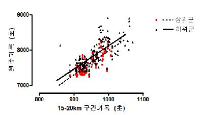





This study was to explore and confirm factors of sport psychology counseling needs in Korean elite coaches. In order to achieve this purpose, 56 elite coaches in Korean Olympic training center at Taereung and Jincheon responded on open-questionnaire and 260 coaches responded on survey. Open-ended questionnaire responses were analyzed by inductive content analysis and collected survey data were analyzed by exploratory factor analysis and confirmatory analysis. The results were as follows: Firstly, sport psychology counseling needs of elite coaches were competition preparation, negative athlete-coach relationship, athlete private problems, performance degradation, pressure on performance result, injury management, team cohesion degradation, motivation, training management, different gender athlete control, athletes drop out, pressure from outside, conflicts with colleagues, neglecting from athletes, feeling of incompetence, emotional control problem, and so on. Secondly, based on these responses, closed-ended questionnaire was developed, surveyed, and analyzed. Exploratory factor analysis illustrated that sports counseling needs of coaches were performance enhancement strategies, unreasonable pressure, negligence on training, coaching stress, competition result stress, conflicts with athletes. Finally, confirmatory factor analysis showed that construct of sport counseling needs illustrated appropriate fit indices values. The results of this study contributed to provide fundamental information on coaching education program and sport psychology counseling program development and application. Consequently, it will help coaches to control their mind at coaching in training and competitions.


The purpose of the study was to provide managers and owners of fitness center with new marketing strategies for distinction strategies of quite competitive Korean fitness industry with analysis of mediating effects of consumption emotion within the relationship of fitness selection attribute and customer satisfaction. This paper chose fitness center customers as population of this study who registered in each 5 fitness centers in Seoul and Gyeonggi using convenience sampling. For this study, 400 questionnaires were given fitness center customer. For the analysis of data, 376 questionnaires were used using SPSS 15.0 Windows and Amos 7.0. To examine respondents demographics traits, frequency analysis was processed and reliability analysis, confirmatory factor analysis and correlation analysis for relationship among the variables were conducted. For the verification of model suitability and research hypotheses, the mediating effects were tested by using Bootrapping method and Aroian-test through structure equation modeling. The significance level was set at α=.05, and the results are as follows. First, Among fitness selection attribute variables, structural strategy, cost, a trainer and program had significant influence on customer satisfaction, but, atmosphere and facilities had not significant on customer satisfaction. Second, Among fitness selection attribute variables, structural strategy, cost, a trainer and atmosphere had significant influence on consumption emotion, but, facilities and program had not significant on consumption emotion. Third, consumption emotion had significant influence on customer satisfaction. Fourth, consumption emotion fully mediated in the relationship between fitness selection attribute and customer satisfaction.


PURPOSE This study aims to provide policy recommendations for the development of women’s football and the enhancement of the Women’s University Football League (WUFL) by examining participant satisfaction and meaningfulness of football. METHODS To achieve this goal, we distributed survey questionnaires, including 5-point Likert scale and open-ended questions, and subsequently analyzed 153 responses using qualitative data analysis software, N-vivo. RESULTS Our findings reveal that female students actively engaged in the WUFL express high overall satisfaction. Furthermore, participants perceive football as a source of happiness, an energy booster, and a platform for new experiences. Their involvement in football goes beyond typical leisure; it is regarded as a form of serious leisure. DISCUSSION AND CONCLUSIONS Based on these results, we propose actions such as fostering and elevating amateur women’s competitions, promoting female students’ participation in football, and developing a comprehensive strategy for increasing women’s enjoyment of playing football.
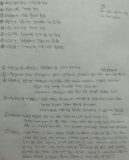
Values, such as development and social responsibilities, are added on victory-oriented Korean sport. Those change of values are along with discussions regarding improvement of players’ training environment, however, discussions on improvement of players’ training environment so far rather focused on ideological concepts, such as players’ holistic human development and human rights, therefore, there was a lack of discussion on practical training methods or teaching methods. This study focused on mental coaching as a specific method for improvement of players’ training environment. Mental coaching provides players with performance enhancement, personal growth, and self-actualization utilizing mental training, consulting, and mentoring in their training processes. This study examined a possibility of introduction of mental coaching as a training camp method for players by creating a training camp reflected on mental coaching perspectives and verifying the program effects of application. First of all, a mental coaching training camp was created through consultations with mental coaches, supervisors, and coaches. Goals of the mental coaching training camp were development of competition-routines, establishment of competition-circumstance coping strategies, comprehension of elite-players’ psychological resources, goal-setting, and motivation and the program consist of badminton competitions, mental education, a special lecture by an Olympic gold medalist, tracking, and sharing. The mental coaching training camp proceeded with middle and highschool badminton players and 31 coaches during three-days and four-nights. As results, the training camp was effective for players’ performance enhancement, personal growth, and self-actualization and team coaches realized a necessity of improvement in terms of their training and teaching behaviors. In other words, mental coaching training camp played a role as a source of long-term change as well as short-term results, thus, this study verified that the mental coaching can be introduced as a training camp method. It is anticipated that this study can provide sport fields and academic sport areas with an opportunity to consider both training contents and methods when it comes to discussion players’ training environment development.


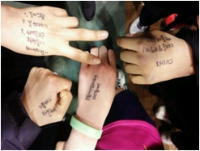
PURPOSE This study aimed to establish a standardized evaluation of the consistency and reliability of the results of the 2018 Buenos Aires Youth Olympics. METHODS The results of the preliminary and the final rounds of the individual Boys and Girls competition of the 2018 Buenos Aires Youth Olympics were collected. Data were organized using Microsoft Windows Excel 2021. Windows SPSS 26.0 was used for descriptive statistics. Intraclass correlation coefficient calculation was used to analyze the evaluation score. The winner/loser decision, and the evaluation interrater agreement was confirmed using Fleiss' kappa. RESULTS There was a difference in the scores given by the judges in both the preliminary and final rounds of both competitions. A low correlation was observed between the decided winner of the judges, and the point variance for each item. CONCLUSIONS In the trivium value system, differences in the evaluation strategies of the judges may exist. Thus, improvements to standardize evaluation should be implemented. In addition, this scoring system considers various factors in the evaluation process, and the scoring system is complicated. Therefore, there may be a need to revise the evaluation system and find the optimal number of judges to create a better evaluation.

[Purpose] This study aimed to investigate the structural relationships among event quality, spectators‘ destination image, country image, and behavioral intention in the international cycle competition, Tour de Korea 2017. [Methods] The questionnaire was structured in four dimensions: event quality (three sub-dimensions and twelve items), destination image (three items), country image (three items), and behavioral intention (four items). A total of 292 spectators from six hosting cities (Yeosu, Gunsan, Muju, Yeongju, Cheongju, and Seoul) during the event participated in this study. Factor analysis, reliability, validity, correlation analysis, and structural equation modeling analysis were conducted utilizing SPSS 21.0 and AMOS 21.0. [Results] This study indicated that event quality in an international sporting event was found to be the significant factor of spectators’ destination image and country image, which, in turn, significantly influenced the spectators’ intention to revisit to the place of the event and/or the event itself. [Conclusions] The findings of the present study contribute to theoretical understandings of event quality that predicts spectators’ behavioral intention and destination image in a global sporting event. Practically, this study also provides some important suggestions for practitioners who plan marketing strategies for international sporting events.
